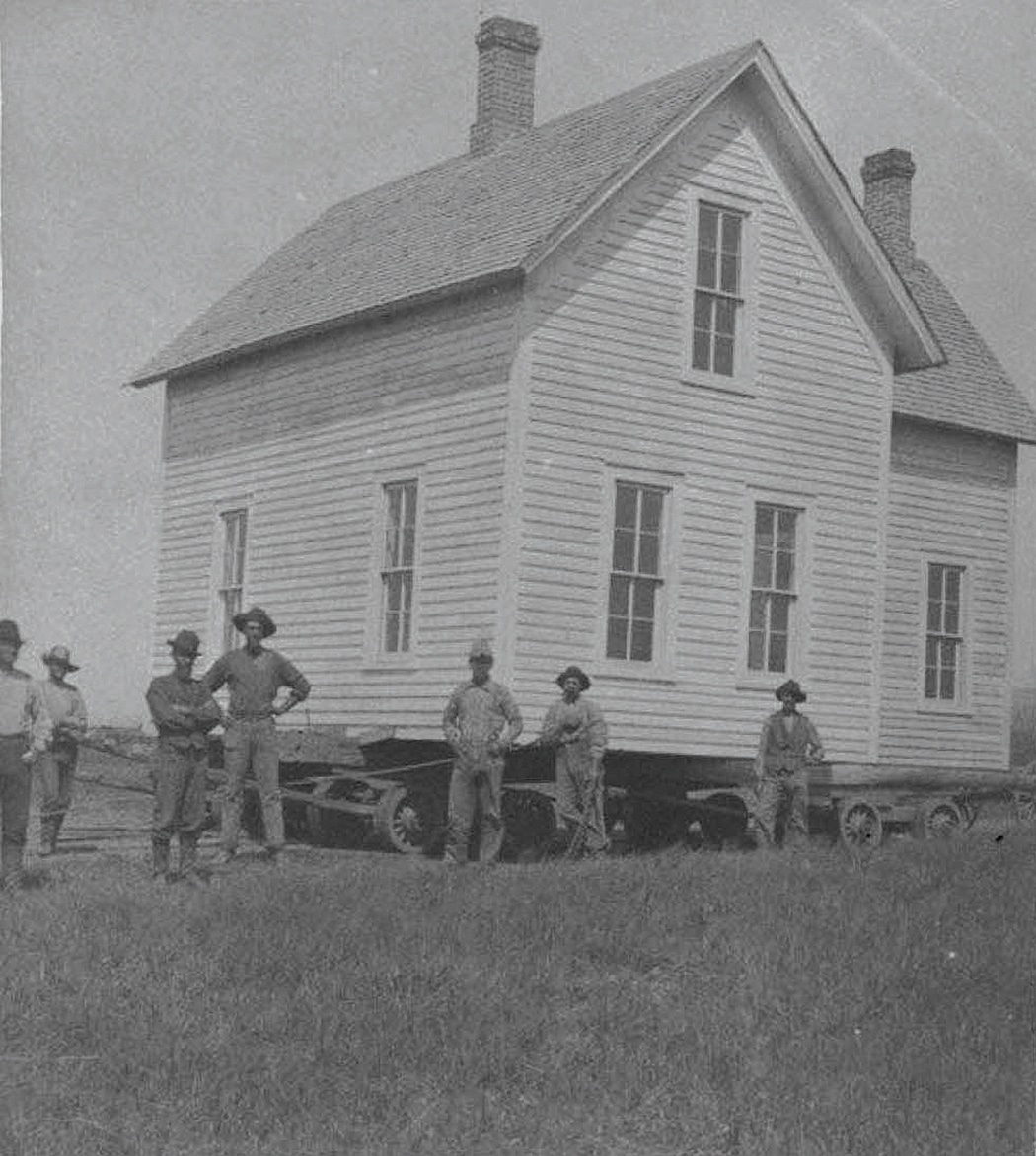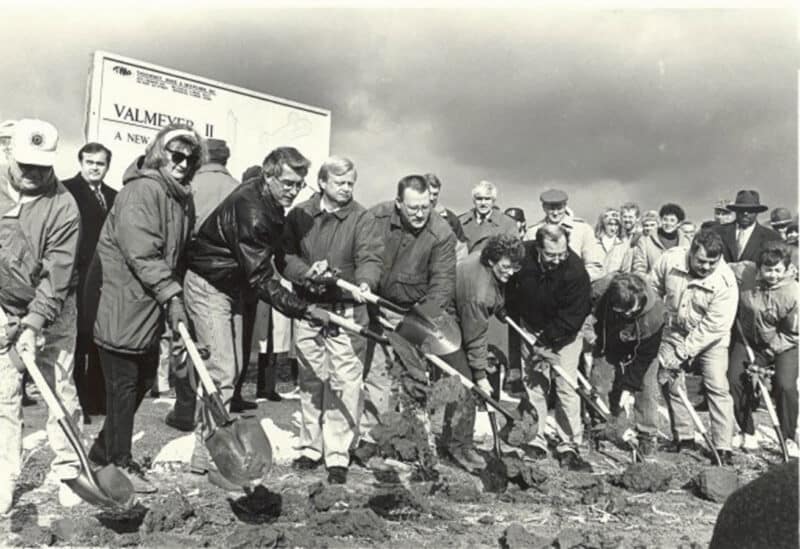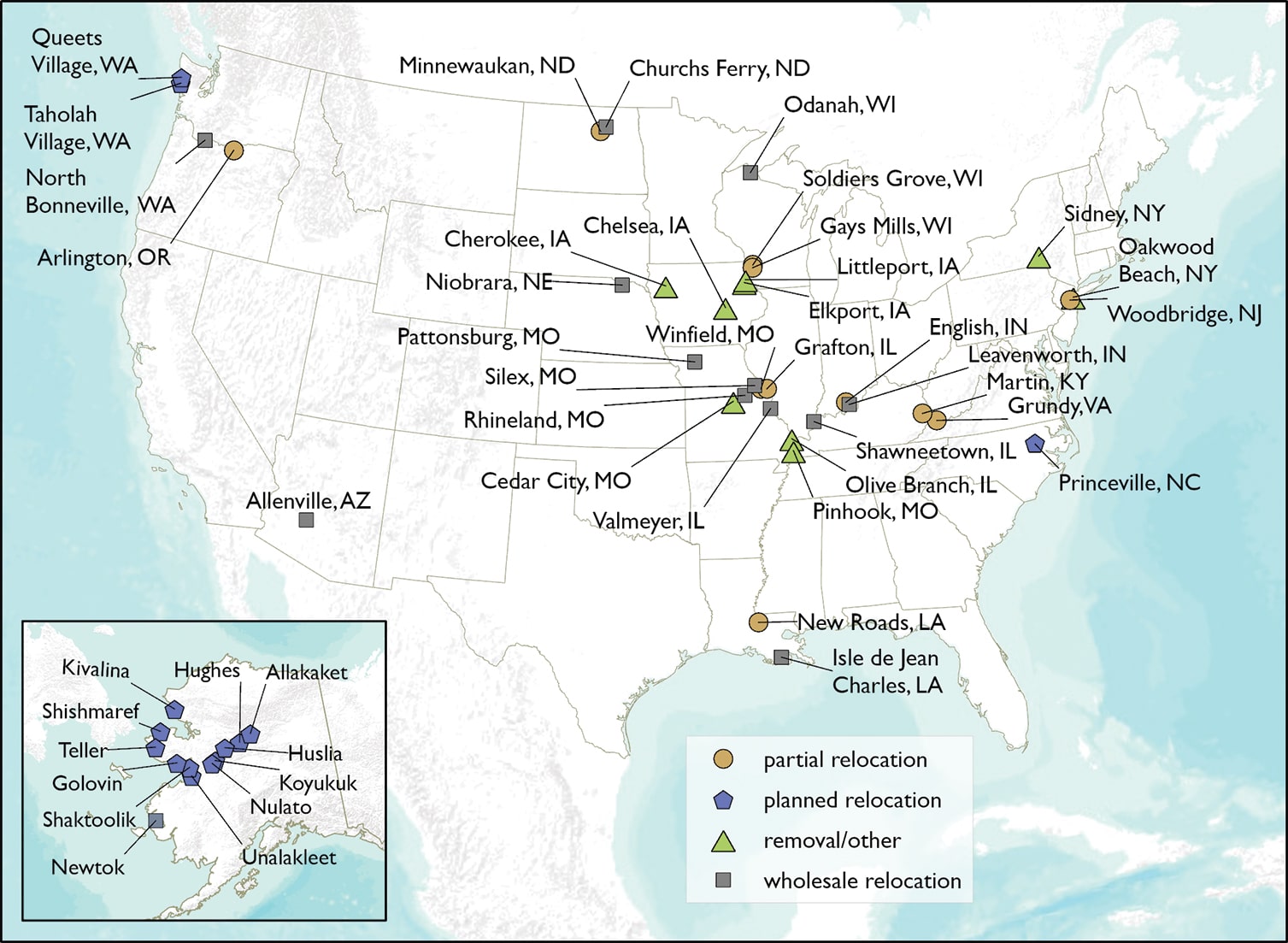True Stories of Managed Retreat From Rising Waters
As more communities face threats from rising sea levels and climate-induced flooding, a rich 140-year history of relocation projects offers valuable insights.
As communities across the United States and around the world are increasingly threatened by climate-driven flooding and sea-level rise, academic researchers and disaster managers alike agree that managed retreat—the abandonment of occupied land and the removal or relocation of population and infrastructure—will eventually be unavoidable. By 2100, nearly 500 US coastal communities and 4.2 million US residents could face disruptive inundation, and worldwide damages and fatalities from flooding could more than double. In light of these projections, a number of new, expensive, and publicly contentious managed-retreat projects are already being discussed, planned, and implemented.
Managed retreat is often framed as an alternative to engineering-focused, defend-in-place strategies like the colossal seawall recently proposed for Miami. The relocation of entire communities, in particular, offers up tantalizing benefits over piecemeal buyouts or removal from at-risk locations; wholesale relocation can eliminate flood risk or other hazards while maintaining the social fabric of a community.
The US Government Accountability Office (GAO) recently “identified few communities in the United States that have considered climate migration as a resilience strategy, and [just] two … that moved forward with relocation.” The GAO and others seem to be unaware that the United States actually has a long history of managed retreat and community relocations. The stories of these towns and the new communities they attempted to build show that managed retreat is not just a theoretical exercise; each case study offers key data for planning and implementing such projects in the future.
Early retreats

Niobrara, Nebraska, is the earliest well-documented US wholesale flood relocation. It occurred more than four decades before US disasters became the responsibility of the federal government. In March of 1881, an ice dam on the Missouri River inundated the floodplain up to 100 miles upstream, putting Niobrara under more than six feet of water. In the aftermath, residents elected to move the entire town. Within two months, buildings were jacked up from their foundations and dragged upslope by horse teams to the new town site a mile and a half away. By January of 1882, most homes and all the town’s commercial structures were in place, and flooding in Niobrara was successfully mitigated for the next 80 years. But that changed with the construction of Gavins Point Dam downstream, which caused sediment to accumulate, raising the groundwater and inundating the community from below. In 1971, 90% of Niobrara’s residents voted to move the town again with the goal of “building a model rural town.” The third version of Niobrara was rededicated in July 1977, at a cost of $14.5 million.
Early nationwide interest in retreat was also spurred by catastrophic flooding of the Ohio River in 1937. Against the backdrop of the Great Depression, the Dust Bowl, and New Deal initiatives to alleviate public suffering, President Franklin Roosevelt proposed moving towns flooded in 1937 to higher ground. Heeding this call, the American Red Cross adopted Leavenworth, Indiana, and the town’s relocation off the Ohio River floodplain became the organization’s showpiece accomplishment. By the end of 1938, New Leavenworth was complete. According to a local newspaper, “They pulled Leavenworth out of the slimy muck of the Ohio river banks and today it was transplanted on a hill high above the menace of future floods.”

Shawneetown, Illinois, 140 miles downstream of Leavenworth, was also ruinously flooded by the Ohio River in 1937. Shawneetown’s relocation was a fractious collaboration between town leaders and the Works Progress Administration (WPA). Shawneetown locals criticized WPA designers and engineers as “high-salaried outsiders,” while the WPA perceived the local leadership as amateurish, disorganized, and self-serving, as David Welky noted in his book, The Thousand Year Flood: The Ohio-Mississippi Disaster of 1937. New Shawneetown today is tidy and lively, if not exactly bustling, and surprisingly unassuming given its position 80 years ago at the epicenter of national news, New Deal politics, and utopian visions of rural community design.
Fast-forward to the mid-twentieth century. Soldiers Grove, Wisconsin, on the Kickapoo River, had a long history of flooding, and new ideas about how best to manage US flood risk were beginning to circulate. After damage in 1961, the US Army Corps of Engineers began planning a $55 million dam on the Kickapoo River as well as a levee to protect Soldiers Grove that, at $3.5 million, would cost more than triple the value of all the buildings it would protect. Residents rejected the Corps’ levee proposal, saying, according to the Chicago Tribune, “A levee would turn us from a dying town subject to flooding to a dying town protected from flooding.” Instead, Soldiers Grove leaders proposed relocating half the town off the floodplain. With motivated local leaders, state funding, and federal backing, 24 homes and virtually the town’s entire business district were relocated; additional residences at the floodplain margin were elevated.
“They pulled Leavenworth out of the slimy muck of the Ohio river banks and today it was transplanted on a hill high above the menace of future floods.”
In contrast to the national attention and research focused on Soldiers Grove, the wholesale relocation of Odanah, Wisconsin, has been essentially forgotten. One of four unincorporated communities on the Bad River Reservation of the Lake Superior Chippewa (Ojibwe) tribe, Odanah had a population of several thousand in the late 1800s, but was subject to repeated and catastrophic flooding. During the 1960s, the town was relocated to New Odanah, a little less than a mile west of the Bad River, primarily with financing from the US Department of Housing and Urban Development. As of July 2018, all that remains in “Old Odanah” is the Catholic church and one occupied residential structure.
A new era for flood mitigation
During the summer of 1993, severe flooding along the Missouri and Mississippi Rivers and their tributaries—the Great Flood of 1993—marked a milestone for flood relocation projects. In the wake of this catastrophe and the national attention it attracted, and with mitigation at the forefront of disaster management discussions nationwide, conditions were primed for bold new responses to permanently reduce flood risk.

Three towns completed wholesale moves off the floodplain after being inundated in 1993: Valmeyer, Illinois, and the Missouri towns of Rhineland and Pattonsburg. The Federal Emergency Management Agency (FEMA) had recently established a Hazard Mitigation Grant Program, which provided a new funding mechanism for mitigation projects, including floodplain property acquisitions. The three town relocations were among the approximately 7,700 individual properties acquired by FEMA following the 1993 flood and removed from Midwestern floodplains.
The Valmeyer project is still considered the poster child for wholesale community relocation as a tool for permanently mitigating flood risk. The 1993 floods overwhelmed levees across the Midwest. After Valmeyer’s levee failed, a wave of water rushed across the floodplain and into the town, severely damaging over 90% of the town’s structures. On September 8, 1993, more than two-thirds of residents voted to move the town to a cornfield and surrounding woodland about two miles away and 400 feet higher in elevation. By April 1995, the nascent infrastructure was in place, and the first family of New Valmeyer moved in. In all, about 60% of the original inhabitants moved to the new town. By 2010, with the new town firmly rooted, its population had more than doubled. However, only about 25% of the town’s businesses weathered the three-year transition between the flood and birth of the new town, and the lack of commercial establishments in the central town still persists today.
In Missouri, Rhineland is located upstream of Valmeyer, on the floodplain of the Missouri River, and Pattonsburg is on the Grand River, a tributary upstream of Rhineland. Both towns also completed wholesale relocations after the 1993 flood. Rhineland achieved nearly complete consensus among its residents and succeeded in relocating almost all of its homes off the floodplain and up to the bluffs immediately above. Pattonsburg was flooded and heavily damaged twice in 1993, the 33rd flood in the town’s history. The one-two punch in 1993 jarred 92% of its residents to vote in favor of relocation. Local residents identified several goals for the new town: a “Main Street” feel, a new school, a designated church district, a mix of new and old homes, and green space. After relocation, the old downtown was torched for the filming of the 1998 Civil War–era adventure movie Ride with the Devil. Shortly after filming ended in the summer of 1998, ribbons were cut to mark the opening of the new town.

However, it is important to note that the large majority of the 7,700 floodplain buyouts after 1993 did not involve relocation; most were piecemeal buyouts scattered across the Midwest. Some of the buyouts were concentrated and wiped whole communities from the map; for instance, Cedar City, Missouri, was annexed by neighboring Jefferson City. Rather than relocating, Winfield, Missouri, and Grafton, Illinois, built new neighborhoods to accommodate displaced residents. In contrast, Chelsea, Iowa, voted to follow Valmeyer, Rhineland, and Pattonsburg off the floodplain, but “the reality of the move proved much more contentious than the idea, and just a few homeowners ended up taking … buyouts,”according to a 2008 New York Times article. Chelsea has been heavily damaged since, including by flooding in 2008.
Some communities have sought wholesale relocations but achieved only property-by-property buyouts, which instead led to either significant downsizing or removal. After the Mississippi River flooding in 2011, Olive Branch, Illinois, and Pinhook, Mississippi, actively pursued relocation. Olive Branch received $11.5 million in federal and state buyout funding, but was unable to fund development of its new town site; many residents subsequently left the community. Pinhook, a historically African American town established in 1940, secured funding for buyouts after 2011—but nothing for moving. A few Pinhook residents obtained a small grant, and with labor provided by Mennonite Disaster Services, they built seven houses together in Sikeston, Missouri, 20 miles away.
Recognizing the challenges
In the decades since 1993, community relocations and attempted relocation efforts have included mostly smaller communities or partial moves. For example, consider Churchs Ferry and Minnewaukan, on the shores of Devils Lake, North Dakota. Devils Lake occupies a closed depression within the Red River watershed, and lake levels rise and fall depending on local climate, climate change, and land-cover changes upstream. Water levels began sharply increasing in 1992, and by 2012 had risen over 31 feet, inundating at least 700 structures and several communities and agricultural land around the lake. In 1999, 52 households in the village of Churchs Ferry accepted buyouts from FEMA, essentially removing the community. In contrast, the nearby town of Minnewaukan purchased land about one mile away and built a new school. Several existing homes were also moved to the new location, but the subsequent stabilization of the lake stalled these efforts. Recent satellite imagery shows seven houses at the intended new town site. Construction of a store and gas station, considered imminent in 2013, were never initiated.
The Valmeyer project is still considered the poster child for wholesale community relocation as a tool for permanently mitigating flood risk.
One true successor to the 1993 floodplain relocations is Silex, Missouri, which moved after 2008 flooding on the Cuivre River. Just after the flood, interest in buyouts grew from just a handful of Silex homeowners to all but one of the 74 residences being relocated from the floodplain, sparing them from subsequent flooding in June 2015. However, despite several land parcels reserved for businesses, no nonresidential structures were relocated due to lack of funding and bureaucratic challenges. All of Silex’s remaining businesses were severely flooded again in 2015.
Two other recent relocations—Grundy, Virginia, and Martin, Kentucky (currently ongoing)—represent a new approach to these types of projects in the United States, characterized by intensive engineering and large price tags. Both towns were damaged during flooding of the Levisa Fork River in 1977. Grundy combined a large congressional earmark with state highway funds and engaged the Army Corps of Engineers to carve a 13-acre site from the mountainside on the west side of the river. The historic downtown was demolished and replaced by a strip mall at the new site, anchored by a large Walmart store built atop a publicly funded, two-story parking structure. The town of Martin is now following Grundy’s example. The Corps is excavating a hilltop for a new municipal and commercial center of the town, and elevating up to 180 residences. Funding in Martin includes $33 million secured in 2009 and $80 million in 2018, with federal funds covering 95% of costs; for comparison, total structures in Martin have been valued at around $10.5 million.

Facing a climate-changed future
While several past relocation projects occurred without much fanfare, there has been an explosion of recent interest in managed retreat, including high-profile efforts to move communities. This has been framed largely as a national—and global—strategy for adapting to sea-level rise and other manifestations of climate change.
The historic downtown was demolished and replaced by a strip mall at the new site, anchored by a large Walmart store built atop a publicly funded, two-story parking structure.
In 2012, Hurricane Sandy caused an estimated $62 billion in damages along the US Atlantic Coast. Post-hurricane recovery involved focused mitigation investments, such as the relocation of the Oakwood Beach neighborhood in Staten Island, New York. Every structure in the neighborhood was flooded by Sandy’s coastal storm surge. When a grassroots coalition of neighbors proposed a plan to return the neighborhood to coastal wetlands, Staten Island political leaders initially resisted the buyout effort, citing erosion of the local tax base. But the Oakwood Beach homeowners persisted and, in the face of mounting publicity, local and state leaders eventually embraced the initiative.
Another high-profile project involves theLouisiana community of Isle de Jean Charles, which consists primarily of members of the Biloxi-Chitimacha-Choctaw tribe. Threatened by acute land loss and frequent inundation, the island has lost more than 98% of its landmass, shrinking from 35 square miles in 1955 to just over half a square mile today. In 2016, the US National Disaster Resilience Competition awarded Louisiana $48.3 million to relocate Isle de Jean Charles. The state worked with local residents to assess several potential relocation sites, eventually settling on New Isle, a 0.8-square-mile parcel located 40 miles inland of the current town. The site has been purchased, and 33 households plan to make the move from the old location, with a targeted completion date in 2022. A vocal minority of residents, however, report unhappiness with the new site, the process, and the prospect of abandoning the current town location. They have said they do not plan to move.
The other current focus of attention on US managed retreat is the dozen or so Native American villages in Alaska that are considering or planning to relocate. These communities are threatened by land loss driven by coastal flooding, thawing permafrost, and shoreline erosion. Although some of these communities have discussed relocation and sought funding for decades, the town of Newtok, which consists of about 400 members of the Yup’ik tribe, is further along. In 2003, Newtok negotiated a land transfer with the US Fish and Wildlife Service for a new site roughly nine miles away that is located on solid bedrock. However, it took the town 16 years to obtain funding for relocation. As of 2019, $36.3 million had been allocated from various sources, and on October 12, 2019, 137 residents from 21 households—or about a third of the community—moved into the new town, now called Mertarvik. Construction of additional homes is ongoing and additional funding is still needed to complete the relocation. The remaining Alaskan communities continue to struggle with site selection, funding, and obtaining internal consensus to relocate.
An uncertain path forward
What does this history of past retreat portend for the many thousands—and perhaps millions—of Americans who may have no other choice but to retreat from rising seas and rivers? Each of the projects reviewed here represents millions of taxpayer dollars as well as enormous investment of personal effort, leadership, triumph, and frustration for those directly involved. These lessons cannot be lost.
History suggests that the differences between river and coastal settings—in hydrology and mitigation options—are small compared to the rich diversity in demography, culture, and local context among the communities themselves. Both floodplains and coasts have small and large communities, with strong attachment to their current location, and the near-universal aversion to getting wet shared by most people. Of all the many and significant challenges to mitigating flood hazard by retreating, whether the flood water is fresh or saline is but a small distinction.
A more pressing policy question is whether lessons learned from relocating small communities can be scaled up, perhaps by multiple orders of magnitude. For example, some studies estimate that 4 to 13 million US residents will be impacted by sea-level rise in coming decades, representing trillions of dollars in infrastructure. Even the sweeping damage caused by Hurricane Sandy in 2012 spurred just a few examples of relocation (such as the Oakwood Beach neighborhood in Staten Island) and limited progress with piecemeal buyouts and elevations (like that of New Jersey’s Blue Acres Program), compared to widespread rebuilding in place. Looking at the density and value of infrastructure in coastal cities like Miami or New Orleans, retreat seems unthinkable.
Some studies estimate that 4 to 13 million US residents will be impacted by sea-level rise in coming decades, representing trillions of dollars in infrastructure.
Without a doubt, managed retreat is not a solution for all locations, and at best must be considered as one tool among many available in different settings. However, the scope and scale of which solutions seem “thinkable” can change suddenly. After the 2011 tsunami in Japan devastated the northeastern coast of Honshu, the Japanese government removed all residents from a miles-wide swath of that coastline and rebuilt 145,000 structures, including entirely new towns, on higher ground. The good news is that large-scale relocation is possible; the bad news is that it may take a tragedy such as 20,000 deaths to motivate such transformative action.
Another thorny question is what characterizes success in relocation endeavors. For example, in the United States, FEMA mitigation funding is required to be a utilitarian investment—the cost of mitigation projects must be justified by future savings to taxpayers in the form of disaster damages avoided. However, many social scientists have argued vociferously against this purely financial arithmetic, noting that mitigation projects should consider a much broader range of goals, starting with equity, social justice, and add-on environmental benefits. Looking at the history of relocations to date, it is clear that both financial and nonfinancial criteria are important, and that neglecting either pole of this spectrum can result in catastrophic outcomes. After the 1993 flood, Grafton, Illinois, replaced affordable (although severely flood-prone) structures on the floodplain with high-end housing on the bluffs above the river, in effect gentrifying the community in one swoop using taxpayer funding. At the other extreme, in Isle de Jean Charles, residents have become polarized, ballooning costs and threatening to derail the relocation of a community that will literally disappear into the ocean without concerted action.
Wholesale community relocations can be a solution for balancing financial calculations with other, often intangible benefits. Hydraulic and economic modeling of nine US town relocations by a student and me documented that those investments were, in retrospect, fully justified by losses avoided in subsequent floods. However, every one of these relocations cost substantially more—in many cases double or more—the cost of buyouts to simply remove flooded structures. Using the current FEMA arithmetic, it would have been better to have removed those structures, paid off the residents, and watched them leave. But to residents who were relocated, the added investment has been well worth it, maintaining their cultural fabric, allowing their communities to thrive, and permanently removing the decades-long burden of repeated flooding.
To residents who were relocated, the added investment has been well worth it, maintaining their cultural fabric, allowing their communities to thrive, and permanently removing the decades-long burden of repeated flooding.
Indeed, failures in community relocation can result directly from shortchanging key, sometimes small, elements of these projects. North Bonneville, Washington, was home to at least 30 businesses before the Army Corps of Engineers moved it, but not a single one of the businesses survived the move. The dictum that government funds should be spent on residents but not on businesses has been a severe impediment to many of the relocations reviewed here. At the opposite extreme, congressional earmarks and unbridled spending have threatened to turn recent projects such as Grundy, Virginia, and Martin, Kentucky, into cautionary tales that could threaten public support for all managed retreat.
Local leadership is another key element for successful community relocations. In many cases, that leadership might come from a single person. For example, Dennis Knobloch, Valmeyer’s mayor in 1993, was an indefatigable organizer and cheerleader through the birth of New Valmeyer, and he continues to be an advocate and resource for community relocation to this day. Leaders such as Knobloch are quick to credit the broader support, energy, and efforts of the community, and they move rapidly to enlist outside support. In particular, several projects used full-time professional relocation managers to help shoulder the crushing array of tasks involved in such a project.
In my own experience, local leadership is absolutely necessary, but it is not sufficient. In 2011, I sat in a flood-ravaged building in a flood-ravaged town as FEMA officials told the local team that the agency would not support relocation because there were too many university professors in the room. Personally, I share FEMA’s skepticism of ivory-tower expertise, but more than a decade of on-the-ground involvement with these projects shows that small, rural, and often economically depressed communities lack the experience and resources—both human and material—to even consider relocation without outside help.
Managed retreat and community relocation are not appropriate for all locations and all threats, and retreat is not the only option for addressing flooding and other hazards. But as history reveals, retreat and relocation can provide cost-effective solutions in some circumstances—solutions that also maintain social bonds, promote equity and social justice, and protect or even enhance the local environment. Looking forward, both in the United States and across the world, actionable plans are needed for expanded, and perhaps large-scale, relocations in the future.
